Castles and Town Walls of King Edward in Gwynedd: The well preserved Castles and Town Walls of King Edward in Gwynedd are situated in the former principality of Gwynedd, in North Wales. Nowadays, Gwynedd is part of Great Britain. The castles are examples of the colonization and defence works carried out throughout the reign of King Edward I of England (1272-1307). The castles of King Edward in Wales became known as the Iron Ring of Castles, built to subdue the native people of Wales. The castles of King Edward in Gwynedd played an important role in the conflicts during the centuries, they were involved in the War of the Roses in the 15th century and in the English Civil War in the 17th ventury. The Castles and Town Walls of King Edward in Gwynedd: Caernarfon Castle and the town walls of Caernarfon, Conwy Castle and the town walls of Conwy, Harlech Castle and Beaumaris Castle. The Castles and Town Walls of King Edward in Gwynedd are nowadays very popular tourist attractions. Caernarfon Castle is the most famous castle in Wales. The Castles and Town Walls of King Edward in Gwynedd gained the status as a UNESCO World Heritage in 1986.
www.werelderfgoedfotos.nl © Copyright World Heritage Photos classic car road trip
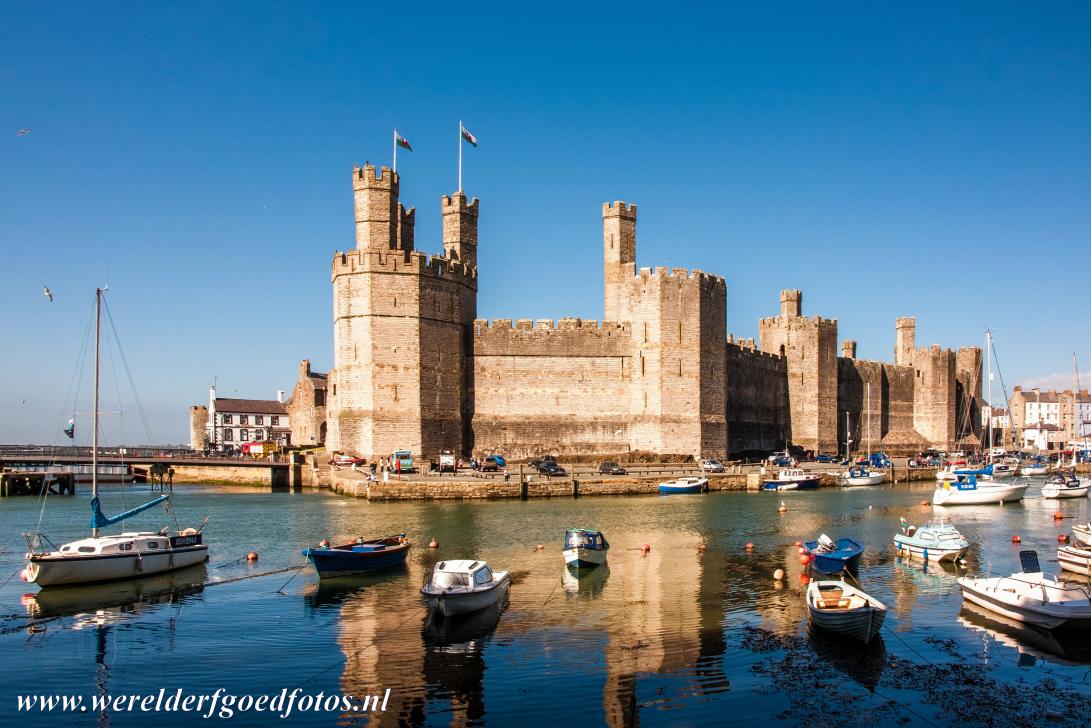
Caernarfon Castle is the most famous castle in Wales. The castle and town of Caernarfon were founded by the English King Edward I. In the Middle Ages, the Edwardian town was the seat of the administrative centre of North Wales. Caernarfon Castle and the town walls are part of the UNESCO World Heritage: Castles and Town Walls of King Edward in Gwynedd.

Caernarfon Castle is the most famous castle in Wales. The castle and town of Caernarfon were founded by the English King Edward I. In the Middle Ages, the Edwardian town was the seat of the administrative centre of North Wales. Caernarfon Castle and the town walls are part of the UNESCO World Heritage: Castles and Town Walls of King Edward in Gwynedd.
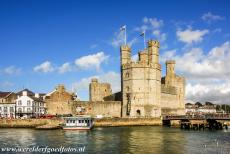
Castles and Town Walls of King Edward in Gwynedd: The Eagle Tower of Caernarfon Castle and the Caernarfon town walls. The castle and town walls were founded by the English King Edward I. The town walls were completed in 1285 and join the walls of the castle. Caernarfon Castle was part of the Iron Ring of Castles, built during the reign of the English King Edward I.
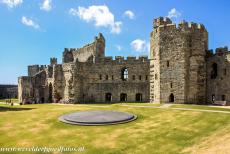
Castles and Town Walls of King Edward in Gwynedd: The Dais of Caernarfon Castle was used for the investiture of the Prince of Wales in 1969. Before the 12th century, the Prince of Wales was a title granted only to the native princes of Wales, but after the conquest of Wales by King Edward I, his son was invested as the first English Prince of Wales, the later King Edward II of England.
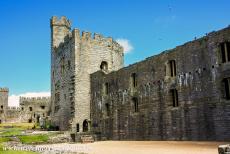
Castles and Town Walls of King Edward in Gwynedd: The mighty Chamberlain Tower seen from the inner ward of Caernarfon Castle. Several buildings of the inner ward no longer survive, other buildings that had been planned in the inner ward were never realized. Caernarfon Castle is an imposing medieval royal fortress situated in the former principality of Gwynedd in North Wales.
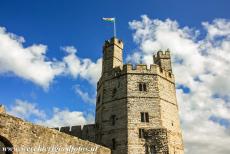
Castles and Town Walls of King Edward in Gwynedd: The Eagle Tower of Caernarfon Castle. The castle was built not only as a military stronghold but also as the seat of the English government in Wales and also as a royal palace. The first English Prince of Wales was born here in 1284, his parents were the English King Edward I and his Queen Consort Eleanor of Castile.
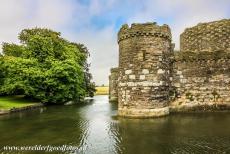
The Castles and Town Walls of King Edward in Gwynedd: The outer curtain wall and the moat of Beaumaris Castle. The castle has two gates, the Gate Next the Sea is the main entrance into the castle. Beaumaris is an Edwardian concentric castle, the construction started in 1295. Beaumaris Castle was the last and largest Welsh castle built by King Edward I of England.
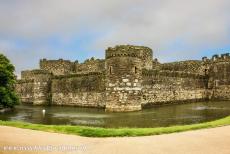
Castles and Town Walls of King Edward in Gwynedd: The outer wall of Beaumaris Castle is more than 4.5 metres thick. The imposing Beaumaris Castle is surrounded by a deep moat. The moat around the castle was filled with water through the tidal flow from the sea. A tidal dock allowed ships to sail right up to the castle and unload their cargo. The moat is almost 5.5 metres wide.
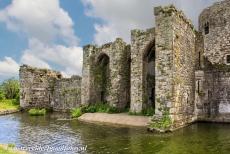
Castles and Town Walls of King Edward in Gwynedd: The landward Llanfaes Gate of Beaumaris Castle. Beaumaris Castle is a medieval stronghold situated on the Island of Anglesey in Wales. Beaumaris Castle was a masterpiece of Master James of St George, the construction started in 1295. The castle consist of a high inner ring of defenses, surrounded by a lower circuit of walls.
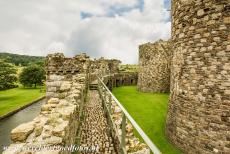
Castles and Town Walls of King Edward in Gwynedd: The outer ward and the Castle Wall Walk of Beaumaris Castle. Beaumaris Castle was never completely finished, after 35 years of work, King Edward was fixated upon subduing Scotland and the money also ran out. Beaumaris Castle was part of the Iron Ring of Castles that was built by the English King Edward I to subdue the Welsh.
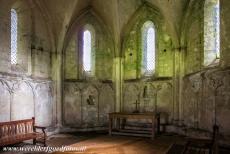
Castles and Town Walls of King Edward in Gwynedd: The tiny Royal Chapel of Beaumaris Castle is situated in one of the six towers of the inner wall. The outer wall was defended by ten towers. The castle fell into a ruin around 1660. Beaumaris Castle is part of the UNESCO World Heritage: Castles and Town Walls of King Edward in Gwynedd.
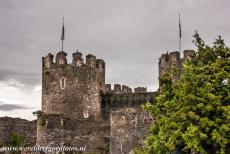
Castles and Town Walls of King Edward in Gwynedd: Conwy Castle and the town walls of Conwy. During his reign, King Edward I built a large number of castles in Wales, only four castles of King Edward I in Gwynedd were declared a UNESCO World Heritage: Beaumaris Castle, Caernarfon Castle, Conwy Castle and Harlech Castle.
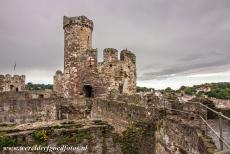
Castles and Town Walls of King Edward in Gwynedd: The Stockhouse Tower is one of the towers of Conwy Castle. The Stockhouse Tower received its curious name during the 16th century when two set of stocks (pillories) were installed in a chamber of the tower to subdue prisoners. Other chambers in the tower were probably used as living quarters for soldiers.
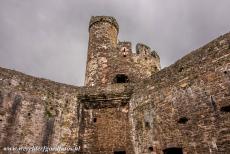
Castles and Town Walls of King Edward in Gwynedd: One of the towers of Conwy Castle. Conwy Castle was an impressive stronghold, surrounded by water on three sides. The 1.7 metres thick town walls of Conwy also served as the outermost defence line of the castle. The townwalls of Conwy were built in the period 1283-1289, around the same time as Conwy Castle.
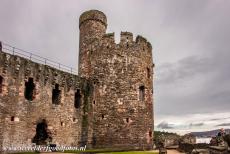
Castles and Town Walls of King Edward in Gwynedd: The Chapel Tower of Conwy Castle. Conwy Castle was part of the Iron Ring of castles that was built by the English King Edward I to subdue the native people of Wales. Conwy Castle was constructed in 1283-1289. Eight huge towers and two barbicans give Conwy Castle in intimidating presence.
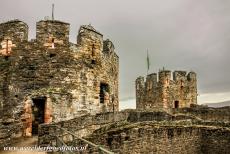
The Castles and Town Walls of King Edward in Gwynedd: The Conwy town walls are completely intact. The walls are nine metres high, the circuit of the walls is 1,3 km in length with 21 towers at regular intervals and three gate houses. The main gate was protected by the northwest and southwest towers. Conwy Castle and the town walls were declared a UNESCO World Heritage.
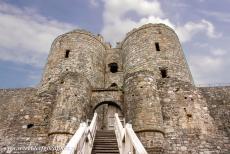
Castles and Town Walls of King Edward in Gwynedd: The main gate house is the most imposing structure of Harlech Castle. As greatest castle-building king of Britain, Edward I of England built round towers, it is more difficult to rest a siege ladder against a round tower and they were also more difficult to undermine than square towers. Harlech Castle is a UNESCO World Heritage.
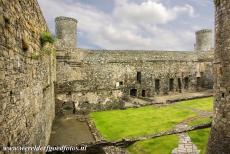
Castles and Town Walls of King Edward in Gwynedd: The inner ward of Harlech Castle. Harlech Castle was part of the Iron Ring of Castles that was built by the English King Edward I to subdue the Welsh. The architecture of the castle has close links to that of the castles in the Kingdom of Savoy in the same period, due to the influence of the Savoy architect Master James of St George.
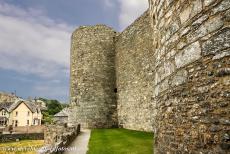
The Castles and Town Walls of King Edward in Gwynedd: The Chapel Tower of Harlech Castle. In the 16th century, the Chapel Tower probably contained an artillery workshop. In later centuries, the castle fell into decay. Harlech Castle is situated in the historic town of Harlech in Gwynedd in Snowdonia, the largest National Park in Wales and renowned for its rugged landscape.
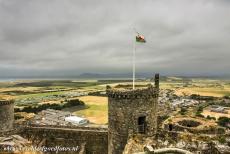
Castles and Town Walls of King Edward in Gwynedd: The Irish Sea seen from one of the towers of Harlech Castle, the mountains of Snowdonia rise in the background. None of the Edwardian castles in Wales has a more spectacular setting than Harlech Castle. Harlech Castle was built on a rock, close to the Irish Sea, defended by cliffs and a deep moat.
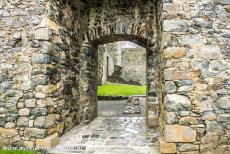
Castles and Town Walls of King Edward in Gwynedd: The Gate House of Harlech Castle viewed from the courtyard. At the rear of the castle, a watergate overlooks a fortified stairway of 127 steps that runs down to the foot of the steep cliffs. The Irish Sea came up close to the stairway and allowed ships to unload their cargo. Nowadays, the sea has retreated about 800 metres.
